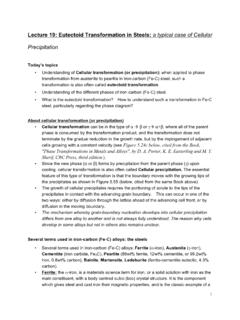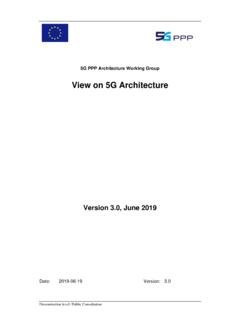Transcription of Chapter 4: network layer
1 1 network layer 4-1 Chapter 4: network layer Chapter goals: understand principles behind network layer services: network layer service models forwarding versus routing how a router works routing (path selection) broadcast, multicast instantiation, implementation in the Internet network layer 4-2 introduction virtual circuit and datagram networks what s inside a router IP: Internet Protocol datagram format IPv4 addressing ICMP IPv6 routing algorithms link state distance vector hierarchical routing routing in the Internet RIP OSPF BGP broadcast and multicast routing Chapter 4: outline 2 network layer 4-3 network layer transport segment from sending to receiving host on sending side encapsulates segments into datagrams on receiving side, delivers segments to transport layer network layer protocols in every host.
2 Router router examines header fields in all IP datagrams passing through it application transport network data link physical application transport network data link physical network data link physical network data link physical network data link physical network data link physical network data link physical network data link physical network data link physical network data link physical network data link physical network data link physical network data link physical network layer 4-4 Two key network - layer functions forwarding: move packets from router s input to appropriate router output routing: determine route taken by packets from source to dest. routing algorithms analogy: routing: process of planning trip from source to dest forwarding: process of getting through single interchange 3 network layer 4-5 1 2 3 0111 value in arriving packet s header routing algorithm local forwarding table header value output link 0100 0101 0111 1001 3 2 2 1 Interplay between routing and forwarding routing algorithm determines end-end-path through network forwarding table determines local forwarding at this router network layer 4-6 Connection setup 3rd important function in some network architectures.
3 ATM, frame relay, before datagrams flow, two end hosts and intervening routers establish virtual connection routers get involved network vs transport layer connection service: network : between two hosts (may also involve intervening routers in case of VCs) transport: between two processes 4 network layer 4-7 network service model Q: What service model for channel transporting datagrams from sender to receiver? example services for individual datagrams: guaranteed delivery guaranteed delivery with less than 40 msec delay example services for a flow of datagrams: in-order datagram delivery guaranteed minimum bandwidth to flow restrictions on changes in inter- packet spacing network layer 4-8 network layer service models: network Architecture Internet ATM ATM ATM ATM Service Model best effort CBR VBR ABR UBR Bandwidth none constant rate guaranteed rate guaranteed minimum none Loss no yes yes no no Order no yes yes yes yes Timing no yes yes no no Congestion feedback no (inferred via loss) no congestion no congestion yes no Guarantees ?
4 5 network layer 4-9 introduction virtual circuit and datagram networks what s inside a router IP: Internet Protocol datagram format IPv4 addressing ICMP IPv6 routing algorithms link state distance vector hierarchical routing routing in the Internet RIP OSPF BGP broadcast and multicast routing Chapter 4: outline network layer 4-10 Connection, connection-less service datagram network provides network - layer connectionless service virtual-circuit network provides network - layer connection service analogous to TCP/UDP connecton-oriented / connectionless transport- layer services, but: service: host-to-host no choice: network provides one or the other implementation: in network core 6 network layer 4-11 Virtual circuits call setup, teardown for each call before data can flow each packet carries VC identifier (not destination host address) every router on source-dest path maintains state for each passing connection link, router resources (bandwidth, buffers) may be allocated to VC (dedicated resources = predictable service) source-to-dest path behaves much like telephone circuit performance-wise network actions along source-to-dest path network layer 4-12 VC implementation a VC consists of: 1.
5 Path from source to destination 2. VC numbers, one number for each link along path 3. entries in forwarding tables in routers along path packet belonging to VC carries VC number (rather than dest address) VC number can be changed on each link. new VC number comes from forwarding table 7 network layer 4-13 VC forwarding table 12 22 32 1 2 3 VC number interface number Incoming interface Incoming VC # Outgoing interface Outgoing VC # 1 12 3 22 2 63 1 18 3 7 2 17 1 97 3 87.
6 Forwarding table in northwest router: VC routers maintain connection state information! network layer 4-14 application transport network data link physical Virtual circuits: signaling protocols used to setup, maintain teardown VC used in ATM, frame-relay, not used in today s Internet 1. initiate call 2. incoming call 3. accept call 4. call connected 5. data flow begins 6. receive data application transport network data link physical 8 network layer 4-15 Datagram networks no call setup at network layer routers: no state about end-to-end connections no network -level concept of connection packets forwarded using destination host address 1. send datagrams application transport network data link physical application transport network data link physical 2.
7 Receive datagrams network layer 4-16 1 2 3 Datagram forwarding table IP destination address in arriving packet s header routing algorithm local forwarding table dest address output link address-range 1 address-range 2 address-range 3 address-range 4 3 2 2 1 4 billion IP addresses, so rather than list individual destination address list range of addresses (aggregate table entries) 9 network layer 4-17 Destination Address Range 11001000 00010111 00010000 00000000 through 11001000 00010111 00010111 11111111 11001000 00010111 00011000 00000000 through 11001000 00010111 00011000 11111111 11001000 00010111 00011001 00000000 through 11001000 00010111 00011111 11111111 otherwise Link Interface 0 1 2 3 Q: but what happens if ranges don t divide up so nicely?
8 Datagram forwarding table network layer 4-18 Longest prefix matching Destination Address Range 11001000 00010111 00010** ** 11001000 00010111 00011000 ** 11001000 00010111 00011** ** otherwise DA: 11001000 00010111 00011000 10101010 examples: DA: 11001000 00010111 00010110 10100001 which interface? which interface? when looking for forwarding table entry for given destination address, use longest address prefix that matches destination address. longest prefix matching Link interface 0 1 2 3 10 network layer 4-19 Datagram or VC network : why? Internet (datagram) data exchange among computers elastic service, no strict timing req. many link types different characteristics uniform service difficult smart end systems (computers) can adapt, perform control, error recovery simple inside network , complexity at edge ATM (VC) evolved from telephony human conversation: strict timing, reliability requirements need for guaranteed service dumb end systems telephones complexity inside network network layer 4-20 introduction virtual circuit and datagram networks what s inside a router IP.
9 Internet Protocol datagram format IPv4 addressing ICMP IPv6 routing algorithms link state distance vector hierarchical routing routing in the Internet RIP OSPF BGP broadcast and multicast routing Chapter 4: outline 11 network layer 4-21 Router architecture overview two key router functions: run routing algorithms/protocol (RIP, OSPF, BGP) forwarding datagrams from incoming to outgoing link switching fabric routing processor router input ports router output ports network layer 4-22 line termination link layer protocol (receive) lookup, forwarding queueing Input port functions decentralized switching: given datagram dest., lookup output port using forwarding table in input port memory goal: complete input port processing at line speed queuing: if datagrams arrive faster than forwarding rate into switch fabric physical layer : bit-level reception data link layer : , Ethernet see Chapter 5 switch fabric 12 network layer 4-23 Switching fabrics transfer packet from input buffer to appropriate output buffer switching rate: rate at which packets can be transfer from inputs to outputs often measured as multiple of input/output line rate N inputs.
10 Switching rate N times line rate desirable three types of switching fabrics memory memory bus crossbar network layer 4-24 Switching via memory first generation routers: traditional computers with switching under direct control of CPU packet copied to system s memory speed limited by memory bandwidth (2 bus crossings per datagram) input port ( , Ethernet) memory output port ( , Ethernet) system bus 13 network layer 4-25 Switching via a bus datagram from input port memory to output port memory via a shared bus bus contention: switching speed limited by bus bandwidth 32 Gbps bus, Cisco 5600: sufficient speed for access and enterprise routers bus network layer 4-26 Switching via interconnection network overcome bus bandwidth limitations banyan networks, crossbar, other interconnection nets initially developed to connect processors in multiprocessor advanced design: fragmenting datagram into fixed length cells, switch cells through the fabric.











